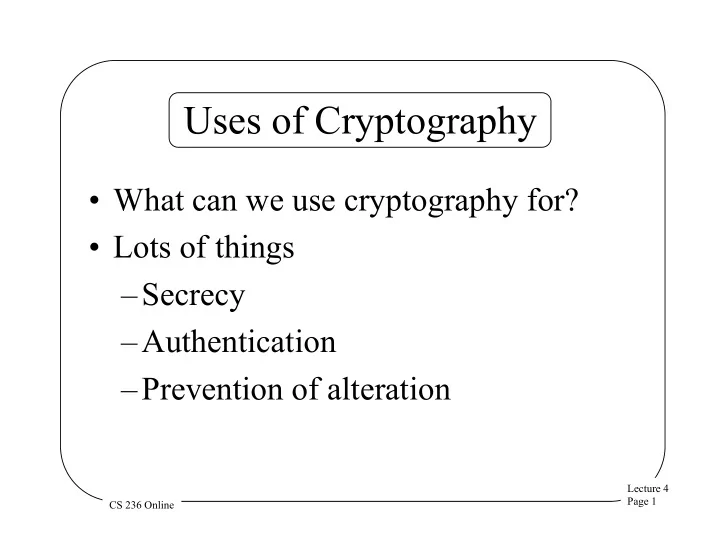

Uses of Cryptography • What can we use cryptography for? • Lots of things – Secrecy – Authentication – Prevention of alteration Lecture 4 Page 1 CS 236 Online
Cryptography and Secrecy • Pretty obvious • Only those knowing the proper keys can decrypt the message – Thus preserving secrecy • Used cleverly, it can provide other forms of secrecy Lecture 4 Page 2 CS 236 Online
Cryptography and Authentication • How can I prove to you that I created a piece of data? • What if I give you the data in encrypted form? – Using a key only you and I know • Then only you or I could have created it – Unless one of us told someone else the key . . . Lecture 4 Page 3 CS 236 Online
Using Cryptography for Authentication • If both parties cooperative, standard cryptography can authenticate – Problems with non-repudiation, though • What if three parties want to share a key? – No longer certain who created anything – Public key cryptography can solve this problem • What if I want to prove authenticity without secrecy? Lecture 4 Page 4 CS 236 Online
Cryptography and Non- Alterability • Changing one bit of an encrypted message completely garbles it – For many forms of cryptography • If a checksum is part of encrypted data, that’s detectable • If you don’t need secrecy, can get the same effect – By encrypting only the checksum Lecture 4 Page 5 CS 236 Online
Symmetric and Asymmetric Cryptosystems • Symmetric - the encrypter and decrypter share a secret key – Used for both encrypting and decrypting • Asymmetric – encrypter has different key than decrypter Lecture 4 Page 6 CS 236 Online
Description of Symmetric Systems • C = E(K,P) • P = D(K,C) • E() and D() are not necessarily the same operations Lecture 4 Page 7 CS 236 Online
Advantages of Symmetric Key Systems + Encryption and authentication performed in a single operation + Well-known (and trusted) ones perform faster than asymmetric key systems + Doesn’t require any centralized authority • Though key servers help a lot Lecture 4 Page 8 CS 236 Online
Disadvantage of Symmetric Key Systems – Encryption and authentication performed in a single operation • Makes signature more difficult – Non-repudiation hard without servers – Key distribution can be a problem – Scaling Lecture 4 Page 9 CS 236 Online
Scaling Problems of Symmetric Cryptography K 5 K 4 K 1 K 4 K 6 I m a K 2 s y e k e l y d n n a a m h o w t o ? d H ? e ? e n ? t o e n t r g e n t i n o I g e r i t n e e h K 5 t K 3 K 3 K 2 K 6 K 1 Lecture 4 Page 10 CS 236 Online
Sample Symmetric Key Ciphers • The Data Encryption Standard • The Advanced Encryption Standard • There are many others Lecture 4 Page 11 CS 236 Online
The Data Encryption Standard • Well known symmetric cipher • Developed in 1977, still much used – Shouldn’t be, for anything serious • Block encryption, using substitutions, permutations, table lookups – With multiple rounds – Each round is repeated application of operations • Only serious problem based on short key Lecture 4 Page 12 CS 236 Online
The Advanced Encryption Standard • A relatively new cryptographic algorithm • Intended to be the replacement for DES • Chosen by NIST – Through an open competition • Chosen cipher was originally called Rijndael – Developed by Dutch researchers – Uses combination of permutation and substitution Lecture 4 Page 13 CS 236 Online
Increased Popularity of AES • Gradually replacing DES – As was intended • Various RFCs describe using AES in IPsec • FreeS/WAN IPsec (for Linux) includes AES • Some commercial VPNs use AES • Used in modern Windows systems – Also recent versions of Mac OS Lecture 4 Page 14 CS 236 Online
Is AES Secure? • No complete breaks discovered so far • But some disturbing problems – Attacks that work on versions of AES using fewer rounds – Attacks that get keys quicker than brute force • But not practical time (e.g. in 2 126 operations) • But unusable crypto flaws often lead to usable ones • Attacks on crypto only get better over time, never worse Lecture 4 Page 15 CS 236 Online
Recommend
More recommend